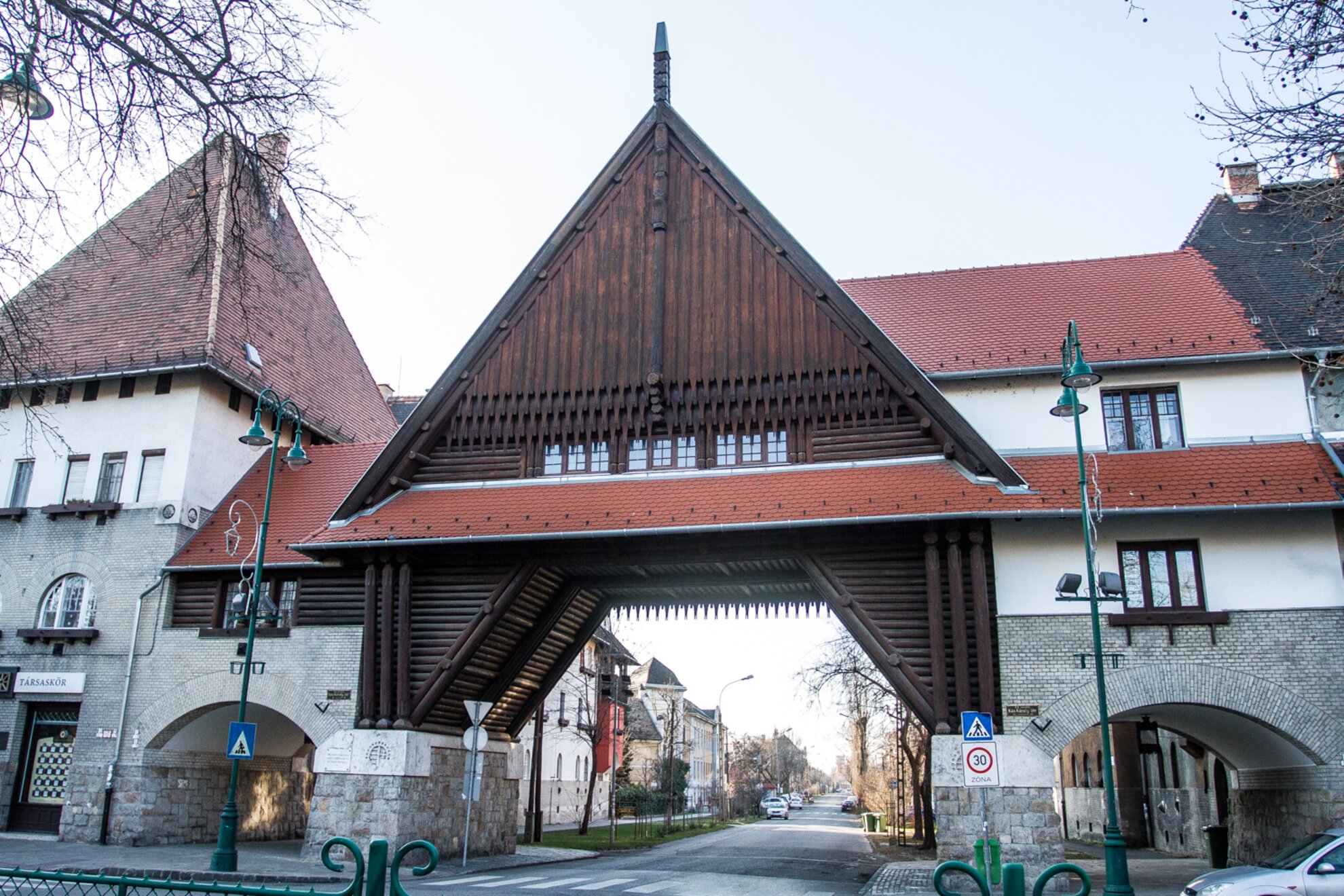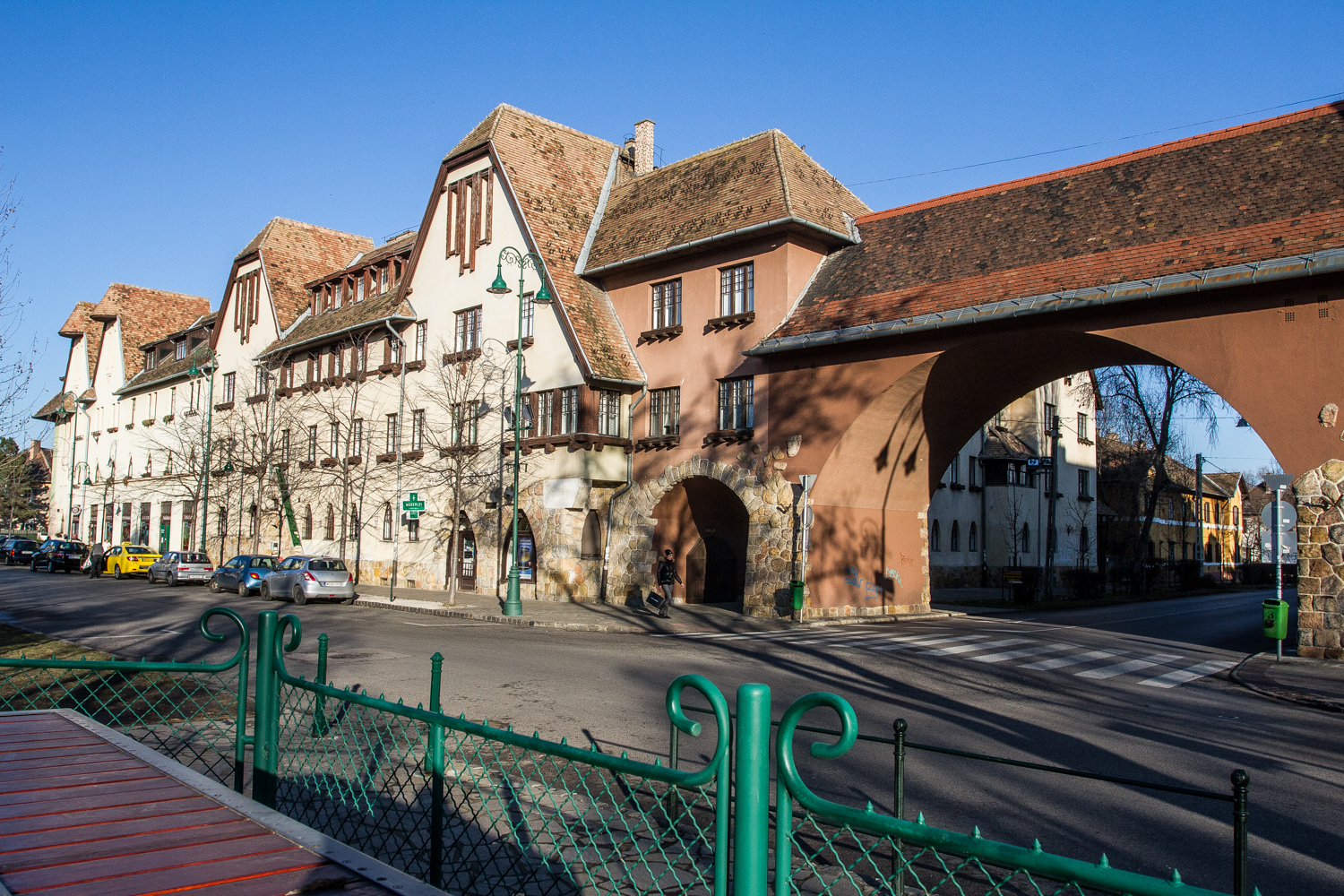Established in District XIX over a century ago as an extraordinarily successful attempt to create a metropolitan suburb that imparts the tranquil feeling of living in a village, the Wekerle Estate (“Wekerletelep” in Hungarian) is the brainchild of renowned Magyar architect Károly Kós. Under the leadership of Prime Minister Sándor Wekerle, Kós gathered several other esteemed building designers of the belle-époque era to create a huge neighborhood of beautiful homes that each bears a distinct personality, with all of them shaped by traditional Hungarian architecture styles of Transylvania.

Laid out on a spiderweb-shaped street grid that effectively funnels traffic while providing numerous open areas for fresh air (enhanced by some 50,000 trees planted here), the Wekerle Estate encompasses over 1,000 quaint-looking homes in varied shapes, sizes, and colors, all revolving around the charmingly spacious parkland of Károly Kós Square.

Ironically, the most direct way of reaching this idyllic neighborhood from downtown is by taking bus 99 from the aforementioned Blaha Square, which does indeed travel through some of Budapest’s roughest regions… yet we are glad to report that this journey is well worth the destination, and is actually much better than we expected it would be.

While waiting at the 99 bus stop before a grimy brick wall among the generally frowning folks milling about near the McDonald’s at Blaha Square, it may be tempting to abandon this adventure before it even begins, but soon after the only-slightly-smelly coach embarks on its journey, we are pleasantly surprised to notice many of the recently completed renovations that now enhance daily life in District VIII. Passing the freshly gentrified green space of Mátyás Square and the shiny-new Teleki Market Hall, we are genuinely impressed at the upgraded state of this frequently maligned neighborhood.

After passing through Népliget Park and some nondescript industrial zones, the semi-modern Europark shopping center lets us know that we’ve reached the Határ Avenue stop – and once the bus starts again, almost immediately afterwards the scenery changes dramatically. Gray-concrete panel buildings are suddenly replaced with low-slung cottages adorned with wooden fences and colorful shutters; instead of garbage, the streets are lined with fallen leaves; smiles radiate from the faces of parents picking up their kids. Two stops after Határ, we disembark at Károly Kós Square and step into a different world.

Here in the Wekerle Estate’s heart, we are immediately overwhelmed by the simply majestic architectural harmony of this central square – each building around it has distinct style, with features like steeply pointed roofs, arched stone doorways, exposed masonry, and a lively palette of muted colors, yet they are connected with the timelessly rustic motifs of customary Magyar housing design. Gigantic gateway arches tower above two of the main roads into Károly Kós Square, while the tall steeple of bright-yellow Saint Joseph Church looms over it all.

Numerous curiosities await discovery within the square itself. Close to the central gazebo topped with swirling blue shingles, a statue of Kós is reverently festooned with candles, flowers, and wreaths to this day – presumably by grateful modern-day residents of his visionary subdivision – and the stepping-stone path that leads to this memorial is lined with artfully carved rocks extolling the neighborhood’s splendor.

Scattered about the surrounding playgrounds and picnic benches frequented by kids roaming freely after school, tall trees stand everywhere; with our visit taking place during winter, we pledged to return during more verdant months to enjoy what must be ample greenery, but for now we appreciate being able to fully admire the square’s carefully coordinated architecture in its more exposed state thanks to the bare branches.

After a tasty cookie and cappuccino at the unpretentiously pleasant Koller Bácsi pastry shop overlooking Károly Kós Square, we take a stroll through some nearby side streets shaded by tree tunnels. Lovingly preserved duplexes and bungalows are made distinct with hand-painted trimming, patterned brickwork, wooden flowerboxes, and countless other small details created with genuine folk-art craftsmanship; beside the backyard gardens and fruit trees, even the toolsheds bear authentic resemblance to rustic countryside cottages. We enjoy the visual feast of arresting architecture amid an utterly peaceful silence unimaginable in most Budapest districts – birdsong is by far the loudest sound here.

It’s easy to drift aimlessly as we follow our curiosity throughout the Wekerle Estate’s interweaving lanes, admiring how this unique street layout creates diverse open spaces in multi-shaped configurations that contain more playgrounds, benches, and trees. No matter how far we wander, it’s easy to find our way back to Károly Kós Square if we just look to the sky for the yellow spire of Saint Joseph Church – although a chance sighting of a mammoth radio tower in the other direction gives us a shocking reminder that we’re still within a major metropolis.

On our way back to the neighborhood’s nexus we stumble upon the unassumingly delightful Wekerle Restaurant; it’s minimally decorated out front with wooden shutters and wrought-iron signage, but inside, the eatery’s warm atmosphere is augmented by modern art with old-time Magyar motifs and an artistically crafted wood-burning tile-coated furnace.

We joyfully devour a bowl of wild-boar goulash soup piled above the brim with savory meat and vegetables and served with deliciously yeasty homemade bread, followed by a huge pair of Hortobágy-style meat-stuffed crêpes with a paprika sauce that is light yet satisfying.

We walk back to Károly Kós Square past an open-air book exchange with full bellies and sensations of peaceful serenity, startled to find ourselves thinking that when we feel like settling down to start a family, this would be an ideal place to do so. Realizing that we must get back downtown before such thoughts gain momentum, we climb back aboard the 99 bus toward Blaha, comforted in knowing that another diverting day-trip to the Wekerle Estate can always be had with a short ride from the city center – even if the journey can be faintly foul.




